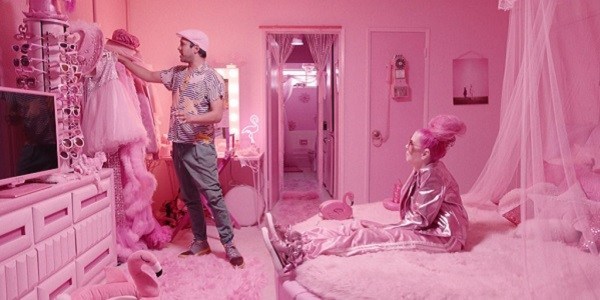THE MYSTERY OF THE PINK FLAMINGO: La Vie En Kitsch
One of my favorite animals on this planet is the pink flamingo. From their fabulous pink color to their simultaneously elegant yet awkward posture, courtesy of their lanky legs and necks, they are like no other creature on Earth, and I find that fascinating. So, naturally, I was thrilled to hear about Spanish filmmaker Javier Polo’s new documentary, The Mystery of the Pink Flamingo, which sets out to discover why so many people like myself love pink flamingos: putting plastic versions in their yards, wearing them on their clothing, and just generally embracing them as sociocultural icons.
Polo’s film is as colorful and quirky as the animals themselves, exploring the oddball appeal of flamingos as well as related topics like kitsch and the color pink. Does it solve the “mystery” of the pink flamingo? Not really. But if you, like me, already love flamingos, you’ll find a lot to enjoy in this high-spirited little film.
Think Pink
Our guide on this journey into the cult of the pink flamingo is a staid sound engineer from Valencia named Rigo Pex. Pex spends his days recording as many sounds as possible, a nondescript presence wandering the streets clad in all black. Yet wherever he goes, he finds himself haunted by a creature who is the exact opposite of him in every way: the flamboyant pink flamingo. When he visits the beach, he sees swimmers with inflatable flamingo floaties. When he sits in the park, he sees people walking by wearing flamingo-patterned shirts. They are practically omnipresent in Pex’s life, so he decides to find out why.

These opening scenes, in which Pex is stalked by flamingos in a variety of forms through both his waking life and his dreams, define the tone of the film that is to follow, which is offbeat almost to a fault. Yet that style and approach make sense as Pex learns more and more about the unique appeal of his subject matter and begins to find the pink flamingo’s influence having a bearing on his own life.
Through Rose-Colored Glasses
Pex interviews a wide, weird range of subjects, from a Miami-based artist whose free-spirited lifestyle is embodied by the flamingo, to a woman whose extensive collection of flamingo items is so famous that visitors come from far and wide to see it, to Kitten Kay Sera, otherwise known as the Pink Lady of Hollywood, who found Internet fame thanks to saturating her entire life — from her hair to her house to even her dog — in the color pink. He chats with indie-pop band Kero Kero Bonito, who have a song called “Flamingo,” renowned songwriter Allee Willis, whose Hollywood home houses the definitive collection of kitsch, and iconic filmmaker John Waters, whose movie Pink Flamingos is a cult classic. In the interest of showing both sides of the issue, Pex even interviews a man who hates flamingos so much that he founded a Facebook group devoted to ranting about how annoying the animals are.

As Pex picks the brains of his interviewees, he finds his own mindset changing. He gradually abandons his black wardrobe for colorful prints and infuses his sound recordings with more experimental qualities. Yet these scenes focused on Pex’s personal quest to embrace the influence of the flamingo in his own life lack the appeal of his interviews with the established flamingo enthusiasts — a phrase I never thought I’d say but is entirely relevant here. Pex’s journey of self-discovery feels stilted and staged, designed to give the film an arc that it doesn’t really need. In contrast, Pex’s interviews with his subjects feel easygoing and natural even in their eccentricities — in other words, much more like the flamingo itself.
The most compelling moments in The Mystery of the Pink Flamingo occur when it looks at the wider appeal of kitsch, of which the pink flamingo, particularly in its plastic lawn-ornament form, is considered a prime example. The film defines kitsch as having “no economic value, but high poetic value,” and I truly cannot think of a better way to describe its appeal. Willis describes kitsch as “a vacation in an object,” which feels particularly relevant to the appeal of the pink flamingo, who is perpetually associated with sunny days and tropical locales. In our current dark times, when leaving one’s house, let alone going on vacation, feels much more dangerous than it’s worth, the pink flamingo provides a welcome respite—and the same can be said for Polo’s film.
Conclusion
A bubbly pink mocktail of a film, The Mystery of the Pink Flamingo embodies the spirit of its subject in wonderfully weird ways that entertain even when they don’t quite hit the mark.
What do you think? Are you fond of pink flamingos? Share your thoughts in the comments below.
The Mystery of the Pink Flamingo is currently available to watch on demand.
Watch The Mystery of the Pink Flamingo
Does content like this matter to you?
Become a Member and support film journalism. Unlock access to all of Film Inquiry`s great articles. Join a community of like-minded readers who are passionate about cinema – get access to our private members Network, give back to independent filmmakers, and more.
Join now!





